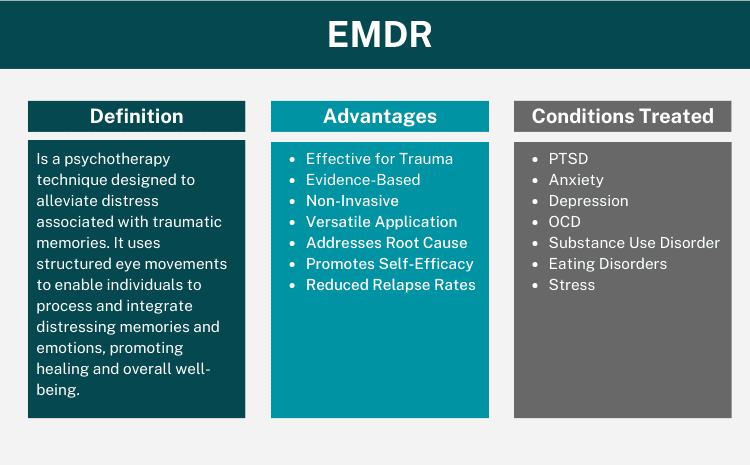Everything Kou Need to Know About Eye Movement Desensitization and Reprocessing
Eye Movement Desensitization and Reprocessing, commonly known as EMDR, is a transformative therapy method that’s gained significant attention in recent years. Especially valuable for those grappling with trauma, EMDR uses unique techniques involving eye movements to help individuals process distressing memories. As you delve deeper into this article, you’ll unravel the intricacies of EMDR and understand why it’s considered a breakthrough in psychotherapy.

What is EMDR?
EMDR, or Eye Movement Desensitization and Reprocessing, stands out as a unique form of psychotherapy. It aims specifically to relieve the distress linked to traumatic memories. Though it is a more recent development compared to traditional talk therapies, it’s gaining acceptance due to its proven effectiveness.
At its core, EMDR seeks to facilitate healing from emotional distress caused by disturbing life incidents. By employing structured eye movements, this therapy aids individuals in processing traumatic memories and allows them to address and handle the ensuing emotions and thoughts. EMDR aspires not just to address trauma but to promote overall well-being.
EMDR’s versatility extends beyond trauma treatment. It has demonstrated efficacy across various mental health conditions, benefiting individuals of all age groups. The therapy’s unique approach, combined with its wide applicability, positions it as a significant advancement in the realm of psychotherapy.
The Origins of EMDR
The origins of EMDR trace back to 1987, highlighted by the insights and observations of Francine Shapiro. Shapiro made her groundbreaking discovery of mitigating disturbing thoughts through saccadic eye movements during a walk in the woods.
Intrigued by this realization, Shapiro formulated the hypothesis that such eye movements could potentially desensitize distressing memories. This hypothesis was not merely a theoretical proposition; Shapiro undertook meticulous experimentation, applying the discovered techniques on herself and others to validate her findings.
This method, conceptualized to alleviate the distress stemming from traumatic memories, has since evolved. The EMDR Institute and the EMDR International Association stand as a testament to the global recognition and the ongoing advancements in this innovative therapy, driving forward its application and refinement.
Understanding the Core of EMDR
Understanding EMDR completely requires an exploration of its foundational components and how they work together to address traumatic memories. In this section, we’ll explore the key elements of EMDR, emphasizing the unique methodologies that make it stand out as a form of therapy.
Bilateral Stimulation and Desensitization
Bilateral Stimulation (BLS) is a fundamental component of EMDR, activating both brain hemispheres to enable the processing of entrenched memories and emotions. The main purpose of BLS is to facilitate the brain in processing and integrating distressing memories and the emotions connected to them, which are lodged in the nervous system. BLS is predominantly applied through eye movements but can also include auditory or tactile stimuli, offering a versatile approach to therapy.
The Role of Eye Movements
Eye movements are a crucial method of bilateral stimulation in EMDR, essential for aiding individuals in focusing on and processing traumatic memories. This method requires the individual to follow the therapist’s finger or a light bar with their eyes, moving back and forth, while contemplating different aspects of the traumatic memory. This integral process underscores the significance of eye movements in the effective implementation of EMDR.
Integrating Memories and Emotions
EMDR aims to change how traumatic memories are stored in the brain, allowing individuals to assimilate these memories in a more adaptive manner. By doing so, the integration helps diminish the distress linked to the memories and promotes the formation of healthier beliefs and emotions, providing a more balanced perspective to individuals.
Brain Engagement and Attention
The engagement of the brain’s information processing system through attention-driven elements of EMDR, coupled with tapping or other forms of stimuli, plays a pivotal role in the therapy. This active engagement fosters the efficient processing and incorporation of traumatic memories, resolving the distress associated with them and fostering mental well-being.
Validating the Effectiveness of EMDR
Eye Movement Desensitization and Reprocessing (EMDR) has established itself as an effective treatment method, backed by rigorous clinical trials and research, earning endorsements from reputable organizations like the American Psychiatric Association. It’s crucial to explore the substantiated effectiveness of EMDR therapy to understand its profound impact on various mental health conditions and its growing acceptance in the psychotherapeutic community.
Benefits of EMDR
Delving into EMDR’s transformative benefits, it is evident that this therapy fosters communication, reshapes perceptions of past events, and encourages the establishment of healthy relationships and boundaries. It alters reactions to rationale, bolsters mental strength, and leverages the brain’s inherent healing capabilities.
- Evidential Support: Numerous studies validate EMDR’s effectiveness in addressing a myriad of psychological challenges, emphasizing its substantial evidential backing.
- Range of Applications: EMDR is versatile, addressing anxiety, panic attacks, phobias, chronic illnesses, medical issues, depression, bipolar disorders, dissociative disorders, addictions, stress, eating disorders, nervous attacks, schizophrenia, and PTSD.
- Therapeutic Outcomes: The outcomes of EMDR are transformative, allowing individuals to experience relief and manage distressing thoughts more effectively.
Debunking Myths and Controversies
Myths and misconceptions are commonplace in psychotherapy. Thus, it’s crucial to make it clear that EMDR does not fabricate false memories; instead, it aids in reprocessing the existing ones. Despite its history of aiding people with PTSD, it is not exclusively for them and has proven beneficial for various conditions. Contrary to some beliefs, EMDR is not a quick fix, a type of hypnosis, or an inherently uncomfortable therapy. Like any form of mental health therapy, it requires commitment and can be challenging but is ultimately aimed at alleviating psychological distress.
Delving into the EMDR Framework
To comprehend the profound efficacy of Eye Movement Desensitization and Reprocessing (EMDR) in psychotherapy, one must delve into its intricate framework. EMDR stands distinct in its mechanism of action, underlying theories, and practical applications, all intricately woven to address traumatic memories and distressing experiences.
How EMDR Works
EMDR is innovative in its approach, emphasizing the memory rather than the ensuing emotions, thoughts, and responses. It aims to alter how memories are stored in the brain, intending to diminish and obliterate the associated symptoms. The process and techniques involved in EMDR are meticulously structured, with a pivotal role assigned to bilateral stimulation. This therapeutic approach is groundbreaking, and its structured methodology is designed to ensure a focused and effective treatment pathway, leading to healing and recovery.
Theoretical Foundations
The conceptual framework of EMDR is deeply rooted in the Adaptive Information Processing (AIP) model. This model proposes that memories connected to traumatic events may remain unprocessed due to the extreme disturbance experienced during the event. If the information related to a distressing or traumatic experience is not fully processed, it will be stored as it was experienced, with the initial perceptions, emotions, and distorted thoughts intact.
Key Components of EMDR
Understanding the key components and phases of EMDR is pivotal for appreciating its structured and comprehensive approach. These phases include:
- History-taking and Treatment Planning: The therapist and client collaboratively identify targets for treatment, including past memories, current triggers, and future goals.
- Preparation: The therapist explains the treatment, introduces the client to the procedures, and ensures that the client has adequate resources for affect management.
- Assessment: This phase activates and assesses each component of the targeted memory: image, cognition, affect, and body sensation.
- Desensitization: The client focuses on the memory while engaging in bilateral stimulation, reporting new thoughts that emerge until the memory is no longer distressing.
- Installation: This phase strengthens the preferred positive cognition associated with the memory.
- Body Scan: Clients observe their physical response while thinking of the incident and identify any residual somatic distress.
- Closure: Used to end the session, ensuring safety and containment if the targeted memory was not fully processed.
- Re-evaluation: The therapist evaluates the client’s current psychological state and identifies targets for the current session at the beginning of the next session.
EMDR in the Context of Addiction
Addiction, a persistent challenge in mental health, often intertwines with traumatic experiences, anxiety, panic attacks, and depression. Eye Movement Desensitization and Reprocessing (EMDR) offers a therapeutic approach that has shown promise in addressing these underlying issues, making it a significant tool in addiction treatment.
EMDR's Role and Benefits in Treating Addiction
When delving into the intricacies of addiction, one cannot overlook the role of trauma. Posttraumatic Stress Disorder (PTSD) and other trauma memories often act as catalysts, propelling individuals into the vicious cycle of substance use. EMDR, renowned for its efficacy in treating PTSD, emerges as a beacon of hope for those battling addiction.
The application of EMDR in addiction therapy is multifaceted. Primarily, it aims to desensitize triggers associated with substance use. By targeting and processing the traumatic memories that often lie at the heart of addiction, EMDR assists individuals in reshaping their responses to potential triggers. The therapy moves beyond mere symptom relief, focusing on reinforcing positive feeling states, which are crucial for long-term recovery.
Moreover, the significance of EMDR in treating Substance Use Disorder (SUD) is profound. It addresses the lurking trauma symptoms, which can intensify the urge for substances like alcohol. By processing these traumatic stressors, individuals gain a better understanding of their addiction, paving the way for a holistic recovery.
In essence, EMDR provides a comprehensive approach to addiction treatment. By integrating trauma-focused therapy with addiction recovery, it ensures that individuals are not just abstaining but genuinely healing.
Initiating EMDR Therapy
Starting EMDR therapy is the beginning of a journey towards mental well-being. This important step involves finding a qualified EMDR therapist and preparing mentally for the therapeutic process, setting the stage for a smoother and more insightful healing journey.
Choosing the Right EMDR Therapist
Selecting a suitable EMDR therapist is pivotal. Prioritize verification of qualifications and find a therapist who aligns with your needs and expectations. A well-matched therapist can significantly influence the therapy’s effectiveness and your overall comfort throughout the process.
Tips and Considerations for Selection
- Research: Initiate your search by researching therapists with credible qualifications and proven experience in EMDR.
- Verify Credentials: Confirm the therapist’s certifications, training, and experience in EMDR.
- Consultation: Seek an initial consultation to assess the therapist’s approach and determine compatibility.
- Specialization: Consider the therapist’s specialization areas to ensure their expertise aligns with your specific needs.
Preparing for Your EMDR Experience
The transition into EMDR therapy, after finding the right therapist, is a vital phase. It is a time to nurture a mental state receptive to the transformative journey ahead. Understanding the essence of preparation is the key to unlocking the full potential of EMDR therapy. Here’s how to delve deep into preparation:
- Understanding the Structure: Familiarize yourself with EMDR’s specific phases to reduce anxiety and uncertainties.
- Setting Realistic Expectations: Establish clear goals with your therapist and understand progress may be gradual.
- Achieving Emotional Readiness: Recognize the potential for intense emotions and develop coping strategies.
- Learning the Techniques: Discuss and practice EMDR techniques with your therapist to become comfortable.
- Reflecting on Personal History: Consider journaling thoughts and memories related to therapy focus points.
- Building a Support System: Inform close ones about your therapy journey for added support.
- Prioritizing Self-Care: Engage in activities that promote relaxation and well-being.
- Remaining Open and Receptive: Trust in the therapeutic journey and be willing to confront distressing memories.
Begin Your Journey
Embarking on EMDR therapy can be a transformative step towards healing and overall well-being. If you or someone you know is struggling with trauma, distressing memories, or other mental health conditions, consider exploring EMDR as a therapeutic option. Seek a qualified EMDR therapist who aligns with your needs and start preparing mentally and emotionally for the journey ahead. Remember, the path to recovery and mental peace is a courageous one, and taking the first step is a commendable effort. Let the journey of self-discovery and healing begin!
